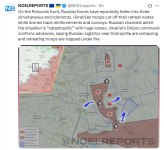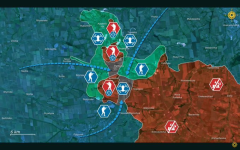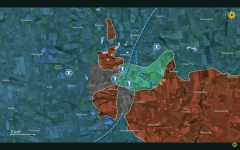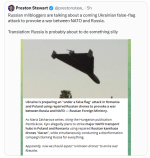ChloeTzang
Literotica Guru
- Joined
- Apr 14, 2015
- Posts
- 18,007
So much for the big Russian breakout this summer.
Ukrainian forces have created their largest encirclement of Russian troops yet in the Pokrovsk direction, trapping enemy soldiers in three separate pockets with no escape routes. The operation relied heavily on drone swarms that hunted down Russian reinforcements and supply convoys before they could reach the frontlines. Ukrainian ground forces liberated 331 square kilometers of territory, including 16 settlements, while systematically cutting off Russian positions from resupply. Russian commanders continue sending reinforcements into what has become a kill zone, feeding more troops into Ukrainian-controlled areas where drones dominate the skies. The encirclements have effectively dismantled Russia's offensive operations around Pokrovsk, turning their planned advance into a defensive disaster.
Ukraine’s troops have started advancing southward, pushing the Russians back and retaking key ground in and around Pankivka. This advance was made possible due to the intensive work of Ukrainian drone operators, working around the clock to spot and destroy every movement of the Russians. As a result, Ukrainian ground forces were able to push forward, and the 1st Azov Corps confirmed that Ukrainian units had fully cleared Pankivka. Russia tried to counter this by rushing in four infantry units and a marine regiment, but Ukrainian tactics of striking reinforcements on the move are blunting every effort.


These tactics, coupled with Russia’s habit of denying surrounded soldiers the permission to withdraw, have now produced a third pocket of trapped Russian troops in the largest encirclement to date, left without supplies or a way out. This has helped the noose to tighten around the Russian positions, and even though Ukrainian advances have already split the battlefield into separate cauldrons, the latest developments between Razine and Boikivka are making matters worse for the Russian command. This strip of land has become a lethal grey zone: any Russian soldier trying to move through it is immediately spotted and targeted by drones. Ukrainian operators dominate the area, preventing resupply convoys or reinforcements from breaking in and even blocking Russian soldiers from pulling back.
Colonel Valentyn Manko, head of Ukraine’s Assault Troops Command, confirmed that Russian forces near Dobropillia have been cut off for three weeks, and there are now three distinct pockets under Ukrainian control. With Ukrainian drones swarming overhead and artillery covering every approach, these Russian formations face the same fate as those in the first northern cauldron that was cleared already.
Amid these developments, President Volodymyr Zelenskyy made a symbolic visit to the front, as a video from the Pokrovsk–Dobropillia axis showed him meeting soldiers engaged in the counter-offensive, presenting state awards, and receiving briefings from commanding General Oleksandr Syrskyi. Zelenskyy used the occasion to underline the scale of Ukraine’s progress in the latest counter-offensive operation, in which, despite tough battles, Ukrainian troops have inflicted the enemy with serious losses. Zelenskyy confirmed that 160 square kilometers have been fully liberated, another 171 square kilometers cleared but not yet consolidated, including 7 freed and 9 cleared settlements.
During the battle for the Dobropillia salient, more than 100 Russians were captured, 1,322 killed, and another 1,134 wounded. The presented numbers match the evidence on the ground, where geolocated footage confirms Ukraine’s steady gains, heavy Russian casualties, and dire situation for the Russian armed forces.
Overall, Ukraine’s multi-layer campaign around Pokrovsk is paying off. By combining air strikes, drone warfare, and persistent raids against Russian depots and supply routes, Ukrainian commanders have choked Russia’s ability to sustain its offensives. Ammunition shortages, disrupted logistics, and depleted reserves have left Russian units unable to consolidate and even hold on to their positions. The result is more territory being retaken by Ukraine, and more isolated pockets of Russian soldiers left to die. With three separate groups now encircled around Dobropillia, Ukrainian forces are well placed to continue their tactic of starving them out before moving in for the kill.
For Russia, each attempt to reinforce these doomed positions simply feeds more troops into the Ukrainian kill zones. Step by step, the encirclements and steady counterattacks are not only reclaiming land but also dismantling the very offensive the Russian command had hoped would break Pokrovsk.

Ukrainian forces have created their largest encirclement of Russian troops yet in the Pokrovsk direction, trapping enemy soldiers in three separate pockets with no escape routes. The operation relied heavily on drone swarms that hunted down Russian reinforcements and supply convoys before they could reach the frontlines. Ukrainian ground forces liberated 331 square kilometers of territory, including 16 settlements, while systematically cutting off Russian positions from resupply. Russian commanders continue sending reinforcements into what has become a kill zone, feeding more troops into Ukrainian-controlled areas where drones dominate the skies. The encirclements have effectively dismantled Russia's offensive operations around Pokrovsk, turning their planned advance into a defensive disaster.
Ukraine’s troops have started advancing southward, pushing the Russians back and retaking key ground in and around Pankivka. This advance was made possible due to the intensive work of Ukrainian drone operators, working around the clock to spot and destroy every movement of the Russians. As a result, Ukrainian ground forces were able to push forward, and the 1st Azov Corps confirmed that Ukrainian units had fully cleared Pankivka. Russia tried to counter this by rushing in four infantry units and a marine regiment, but Ukrainian tactics of striking reinforcements on the move are blunting every effort.


These tactics, coupled with Russia’s habit of denying surrounded soldiers the permission to withdraw, have now produced a third pocket of trapped Russian troops in the largest encirclement to date, left without supplies or a way out. This has helped the noose to tighten around the Russian positions, and even though Ukrainian advances have already split the battlefield into separate cauldrons, the latest developments between Razine and Boikivka are making matters worse for the Russian command. This strip of land has become a lethal grey zone: any Russian soldier trying to move through it is immediately spotted and targeted by drones. Ukrainian operators dominate the area, preventing resupply convoys or reinforcements from breaking in and even blocking Russian soldiers from pulling back.
Colonel Valentyn Manko, head of Ukraine’s Assault Troops Command, confirmed that Russian forces near Dobropillia have been cut off for three weeks, and there are now three distinct pockets under Ukrainian control. With Ukrainian drones swarming overhead and artillery covering every approach, these Russian formations face the same fate as those in the first northern cauldron that was cleared already.
Amid these developments, President Volodymyr Zelenskyy made a symbolic visit to the front, as a video from the Pokrovsk–Dobropillia axis showed him meeting soldiers engaged in the counter-offensive, presenting state awards, and receiving briefings from commanding General Oleksandr Syrskyi. Zelenskyy used the occasion to underline the scale of Ukraine’s progress in the latest counter-offensive operation, in which, despite tough battles, Ukrainian troops have inflicted the enemy with serious losses. Zelenskyy confirmed that 160 square kilometers have been fully liberated, another 171 square kilometers cleared but not yet consolidated, including 7 freed and 9 cleared settlements.
During the battle for the Dobropillia salient, more than 100 Russians were captured, 1,322 killed, and another 1,134 wounded. The presented numbers match the evidence on the ground, where geolocated footage confirms Ukraine’s steady gains, heavy Russian casualties, and dire situation for the Russian armed forces.
Overall, Ukraine’s multi-layer campaign around Pokrovsk is paying off. By combining air strikes, drone warfare, and persistent raids against Russian depots and supply routes, Ukrainian commanders have choked Russia’s ability to sustain its offensives. Ammunition shortages, disrupted logistics, and depleted reserves have left Russian units unable to consolidate and even hold on to their positions. The result is more territory being retaken by Ukraine, and more isolated pockets of Russian soldiers left to die. With three separate groups now encircled around Dobropillia, Ukrainian forces are well placed to continue their tactic of starving them out before moving in for the kill.
For Russia, each attempt to reinforce these doomed positions simply feeds more troops into the Ukrainian kill zones. Step by step, the encirclements and steady counterattacks are not only reclaiming land but also dismantling the very offensive the Russian command had hoped would break Pokrovsk.

Last edited:
